In a vertical farm, plants are grown vertically using hydroponic or aeroponic systems, providing essential nutrients and water without soil. Technology plays a vital role in making vertical farming possible and successful. Through automation, artificial intelligence (AI), Internet of Things (IoT) solutions, robotics, sustainable energy solutions, data analytics, remote monitoring systems, and indoor climate control strategies, all these technologies work together to optimize crop growth while minimizing resource consumption.
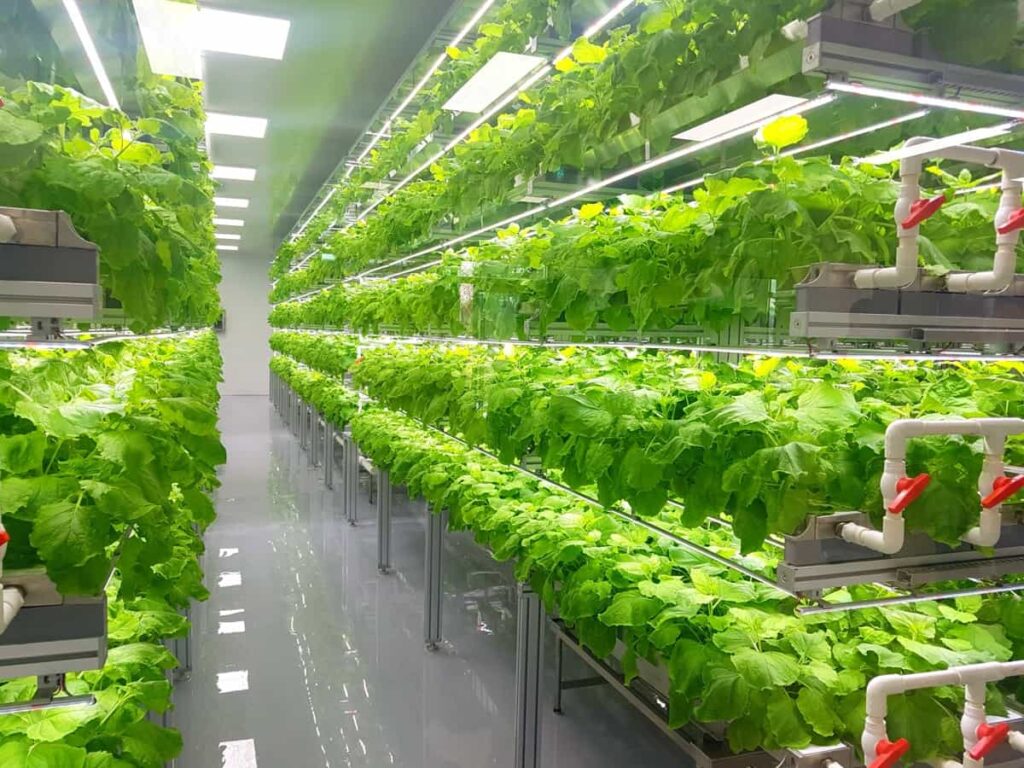
The Role of Technology in Vertical Farming
The Evolution of Automation in Vertical Farming: Enhancing Efficiency and Productivity
Automation has revolutionized how we approach vertical farming, enhancing efficiency and productivity. The key aspect of automation in vertical farming is robotic systems. These intelligent machines can perform labor-intensive tasks such as planting, harvesting, and monitoring plant health.
By reducing manual labor requirements, farmers can save time in crop management. Precision agriculture techniques also play an important role. Through the integration of sensors and data analytics, farmers can gather real-time information about soil moisture levels, nutrient content, and environmental conditions within their farms.
Harnessing the Power of Artificial Intelligence in Vertical Farming: Optimizing Crop Growth and Resource Management
AI analyzes vast amounts of data collected from sensors, cameras, and other IoT devices to provide valuable insights into plant health, nutrient levels, and environmental conditions. Farmers can make informed decisions regarding irrigation schedules, lighting intensity, temperature control, and even pest management with this information at their fingertips.
Moreover, AI-powered automation allows for real-time monitoring of crops on a large scale. Sensors detect any abnormalities or signs of stress in plants early on so that prompt action can be taken to prevent crop loss. Resource management is also optimized through intelligent algorithms that calculate the nutrients needed for each plant at different growth stages. This eliminates wastage while ensuring optimal nutrition delivery for healthy plant development.
IoT Solutions in Vertical Farming: Connecting Sensors, Devices, and Data for Smart Agriculture
IoT solutions allow connectivity between sensors, devices, and data to create a smart agricultural system. Various environmental factors such as temperature, humidity levels, and lighting conditions can be constantly monitored and analyzed by deploying various sensors throughout the vertical farm. These sensors provide real-time data that can be used to make informed decisions regarding crop management.
In case you missed it: Blockchain Technology in Agriculture: A Way to Future Sustainability and Role in Supply Chain
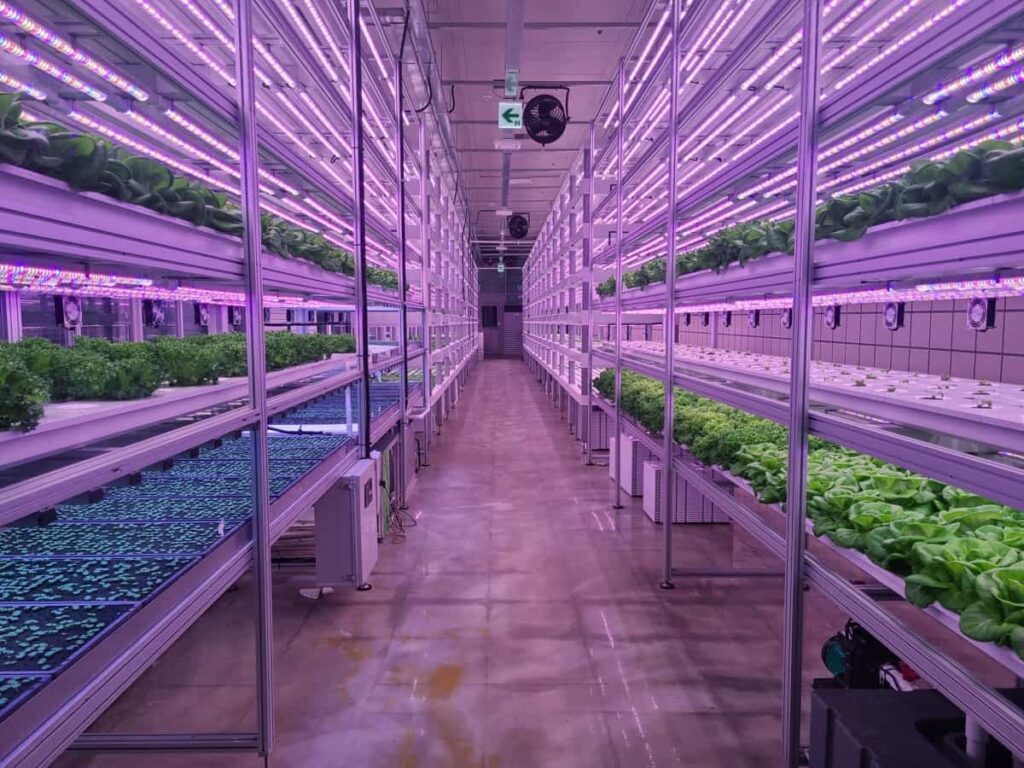
Furthermore, IoT enables automation by connecting devices such as irrigation or nutrient delivery systems to central control hubs. This connectivity allows for precise and efficient resource management. The power of IoT lies in its ability to collect data and its capacity to analyze this information using machine learning algorithms. By leveraging AI capabilities within these connected systems, farmers can optimize their operations further.
The Role of Robotics in Vertical Farming: Streamlining Labor-intensive Tasks
Robotics are Automated machines that have become a game-changer by streamlining labor-intensive tasks and maximizing efficiency. Robots are crucial in vertical farming, from planting seeds to harvesting crops. They can monitor plant health, detect diseases, and apply pesticides or fertilizers. Additionally, robots excel at harvesting crops efficiently and delicately.
With their gentle grip and precision cutting tools, they can pick ripe produce without damaging it or wasting valuable resources. By taking on these labor-intensive tasks previously performed by humans, robots free up valuable time for farmers to focus on other important aspects of farm management. This includes analyzing data collected by sensors throughout the farm or fine-tuning environmental controls for optimal plant growth.
Precision Agriculture Techniques in Vertical Farming: Maximizing Crop Yield and Quality
Precision agriculture techniques are crucial in maximizing crop yield and ensuring top-notch quality. Farmers can monitor and manage their crops with unparalleled precision by leveraging advanced technologies. Sensors collect data on various environmental factors such as temperature, humidity, light intensity, and nutrient levels. This real-time data is then analyzed to make informed decisions about crop management.
With this information, farmers can fine-tune their growing conditions to create an optimal environment for each crop. They can adjust variables like temperature and lighting to mimic ideal growing conditions throughout different stages of plant growth. Vertical farms can achieve higher yields while maintaining consistent quality by providing plants with exactly what they need when they need it. Additionally, automation plays a significant role in implementing these precision techniques effectively.
Sustainable Energy Solutions for Vertical Farms: Integrating Renewable Technologies
Solar panels – Vertical farms can generate clean, renewable electricity to meet their energy needs. Solar panels can be connected on rooftops or integrated into the design of the farm itself, maximizing space utilization while minimizing carbon footprint.
Wind turbines – Vertical farms located in areas with strong winds can use this natural resource by installing wind turbines to generate electricity. The turbines capture kinetic energy from the wind and convert it into electrical power, providing a sustainable energy source for vertical farming operations.
Hydroelectric power – It also offers great potential for vertical farms near bodies of water or utilizing hydroponic systems. These farms can produce clean and renewable electricity by harnessing flowing water through small-scale hydroelectric generators while minimizing their impact on aquatic ecosystems.
Integrating sustainable energy solutions reduces carbon emissions and lowers operational costs for vertical farmers over time. It allows them to contribute positively towards combating climate change while ensuring long-term viability and profitability in their agricultural practices.
In case you missed it: 15 Best Solar Powered CCTV Wireless Cameras for Agricultural Land
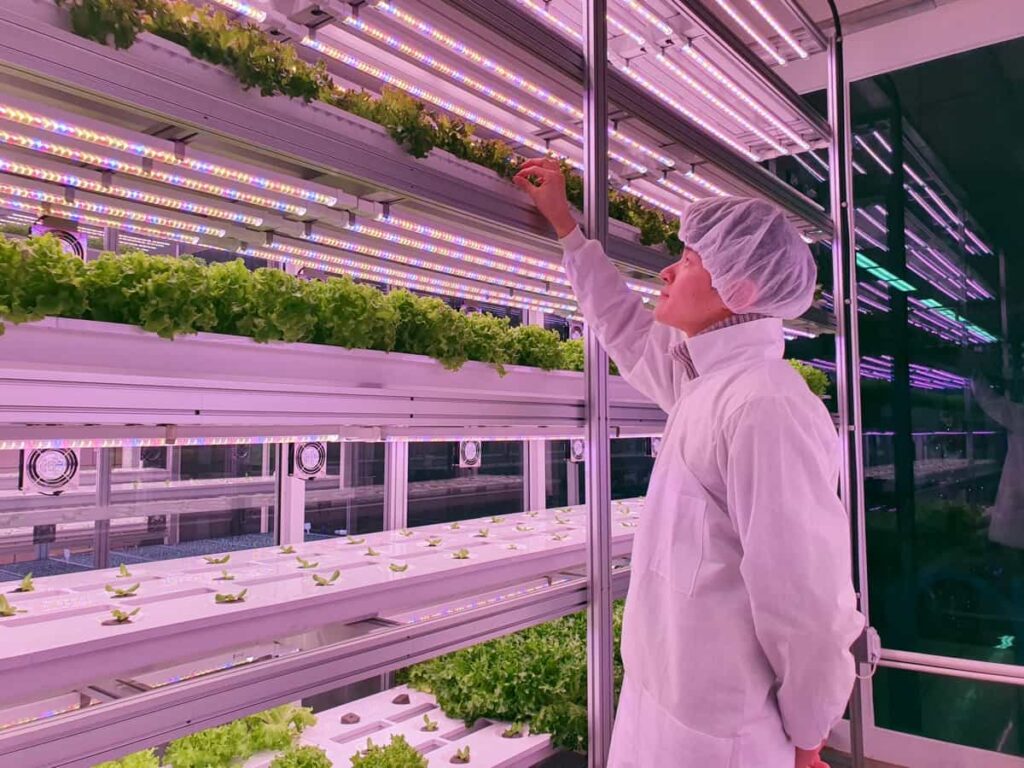
Data Analytics and Predictive Modeling in Vertical Farming: Making Informed Decisions for Crop Management
With the help of advanced technologies, farmers can now analyze vast amounts of data collected from various sources, including sensors, weather forecasts, and historical crop performance. Using algorithms and machine learning techniques, these data analytics tools can identify patterns and trends to predict future outcomes. This enables farmers to make proactive decisions regarding crop management strategies such as irrigation scheduling, pest control measures, and nutrient application.
Predictive modeling also allows farmers to optimize resource allocation by determining the most efficient use of water, energy, and fertilizers based on real-time data inputs. Vertical farms can reduce costs while maintaining high crop yields by minimizing waste and maximizing efficiency through precise calculations. Furthermore, data analytics helps monitor plant health by detecting early signs of diseases or deficiencies.
Remote Monitoring and Control Systems in Vertical Farming: Enabling Real-time Oversight and Intervention
With remote monitoring systems, farmers can keep track of vital parameters such as temperature, humidity levels, lighting conditions, nutrient delivery, and water management. Moreover, remote control systems provide the capability to intervene promptly when necessary. For example, suppose an unexpected temperature increase could harm crops’ growth or trigger disease outbreaks.
In that case, farmers can remotely adjust ventilation or cooling systems without physically being present at the farm. These systems also offer real-time alerts and notifications informing farmers about critical events. Farmers receive instant notifications on their mobile devices if there is a sudden drop in pH levels or a malfunctioning irrigation system detected by sensors. This enables them to take swift action before it escalates into larger problems.
Vertical Farming and Indoor Climate Control: Balancing Temperature, Humidity, and Lighting for Optimal Growth
The main aspect of vertical farming is indoor climate control, which involves maintaining the right balance of temperature, humidity, and lighting. Temperature plays a vital role in plant development. Different crops have specific temperature requirements for germination, growth, and flowering. By carefully monitoring and adjusting the temperature levels within the growing areas, farmers can provide an ideal environment for their crops throughout all stages of growth.
Humidity control is another critical factor in vertical farming. Plants require specific humidity levels to thrive while minimizing the risk of diseases caused by excess moisture. Lighting is perhaps one of the most important aspects of indoor climate control in vertical farming since plants rely on light energy for photosynthesis. These facilities commonly use LED lights because they emit specific wavelengths suitable for different crop varieties.
Water Management Strategies in Vertical Farming: Efficient Usage and Recycling Techniques
The main strategy for efficient water usage in vertical farms is by implementing drip irrigation systems. By precisely controlling the amount of water delivered to each plant, farmers can avoid overwatering while still providing adequate hydration. Another strategy used in vertical farming is hydroponics, which involves growing plants without soil using nutrient-rich solutions.
This method requires significantly less water than conventional agriculture since it eliminates the need for large irrigation. The recirculation of nutrient solutions further reduces water waste by continuously supplying plants with recycled moisture. Some vertical farms incorporate advanced technologies such as sensors and data analytics into their watering systems to maximize efficiency.
Nutrient Delivery Systems in Vertical Farms: Ensuring Proper Nourishment for Plants
By carefully managing the delivery of nutrients, vertical farmers can create an ideal environment that fosters healthy plant growth. Hydroponics involves growing plants in water-based solutions instead of soil. Nutrients are dissolved into the water and delivered directly to the plant roots through irrigation systems or misting techniques. In the Aeroponics system, plants are suspended in air and exposed to a fine mist or fog containing nutrients.
The roots absorb these microdroplets, allowing for efficient nutrient uptake without using soil or traditional irrigation methods. Additionally, some vertical farms employ automated nutrient monitoring and dosing systems. These sophisticated technologies continuously monitor pH levels and nutrient concentrations in the growing medium and adjust accordingly by adding specific fertilizers as needed.
In case you missed it: How to Earn Excellent Income Returns with Commercial Vertical Farming
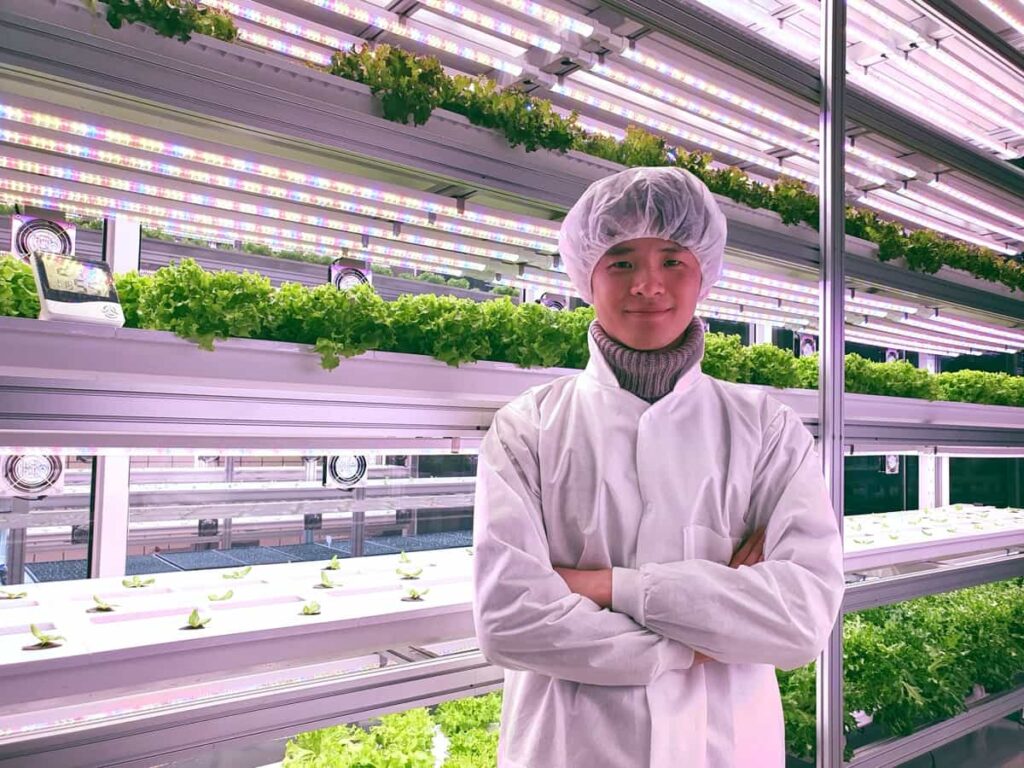
The Role of Sensory Technology in Vertical Farming: Monitoring Plant Health and Detecting Diseases
Sensory technology plays a crucial role in revolutionizing vertical farming by enabling real-time monitoring of plant health and early detection of diseases. With the help of sensors, farmers can closely monitor various environmental factors inside the farm. These sensors provide accurate data that helps optimize growing conditions and ensure optimal growth for crops. Moreover, sensory technology facilitates precision irrigation by measuring soil moisture content and nutrient levels.
By delivering water and nutrients precisely where needed, farmers can avoid overwatering or undernourishing plants, optimizing resource usage while minimizing waste. In addition to monitoring plant health, sensory technology also aids in pest management. Sensory technology empowers vertical farmers with real-time data on crop health status and enables them to make informed decisions regarding crop management strategies.
Integration of Blockchain Technology in Vertical Farming: Enhancing Traceability and Transparency in the Supply Chain
Blockchain has emerged as a powerful solution to address these concerns. By integrating blockchain into vertical farming systems, farmers can record every step of the supply chain process, from seed planting to harvesting and distribution. This level of transparency builds trust between farmers and consumers and enables easier identification of potential issues or contaminants during production.
With blockchain technology, tracking each batch of crops back to its source becomes possible, ensuring accountability at every stage. Moreover, this integration also streamlines logistics operations by automating processes such as inventory management and shipping documentation.
Smart contracts within the blockchain system can automate payments between growers, suppliers, distributors, and retailers based on predefined conditions. By leveraging blockchain technology in vertical farming practices, stakeholders can ensure that all crop cultivation and distribution data is secure yet accessible for verification. It eliminates the need for intermediaries while maintaining an immutable record that fosters trust throughout the supply chain.
Challenges and Future Prospects of Technology in Vertical Farming: Overcoming Limitations and Expanding Opportunities
The major challenge is the initial cost of implementing advanced technology systems. The high upfront investment required for automation, AI, and IoT solutions can deter many potential investors from entering the market. However, as technology evolves and becomes more accessible, these costs gradually decrease. Another challenge is the need for skilled labor to maintain these complex technological systems.
As vertical farms rely heavily on automation and robotics, there is a growing demand for individuals with specialized knowledge in this field. Addressing this skill gap through training programs or collaborations between academia and industry can help overcome this challenge. Additionally, ensuring crop quality control remains a constant concern in vertical farming. Maintaining optimal environmental conditions such as temperature, humidity, and lighting intensity becomes crucial for plant growth.
Moreover, preventing disease outbreaks requires constant monitoring using sensory technology combined with AI algorithms to detect early signs of stress or infection. Expanding opportunities lie ahead for vertical farming as advancements continue in sustainable energy solutions. Integrating renewable technologies like solar panels or wind turbines can reduce reliance on traditional power sources while minimizing carbon emissions associated with food production.
In case you missed it: How to Start Aeroponic Vertical Farming: A Step-by-Step Guide for Beginners
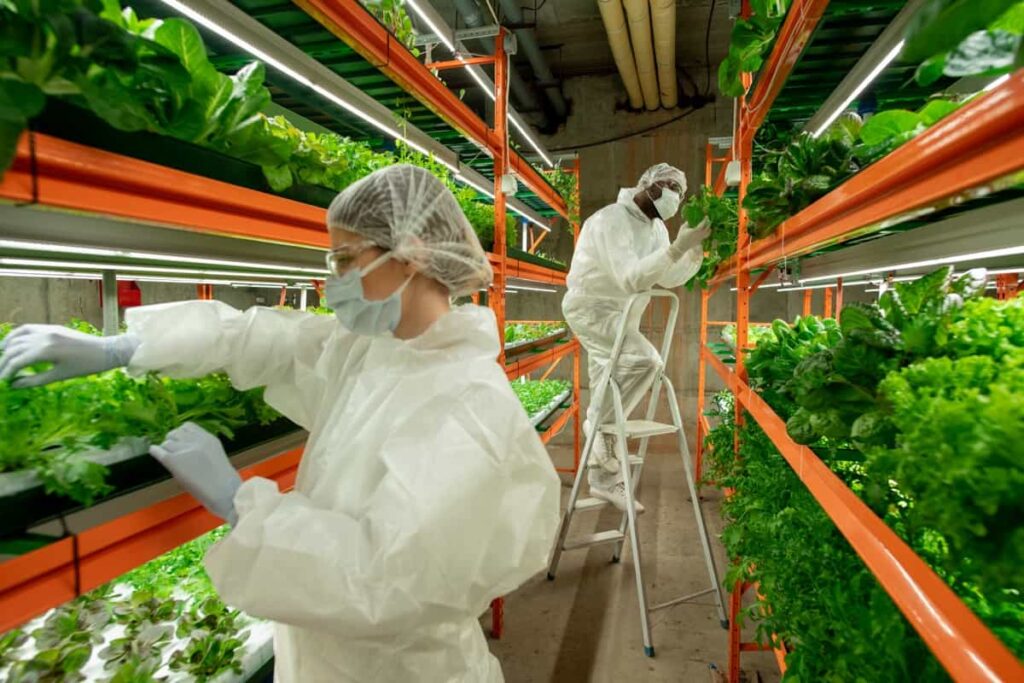
Role of Technology in Vertical Farming
| Technology | Benefits |
| Automation | Planting seeds or harvesting crops efficiently |
| Artificial Intelligence (AI) | Make intelligent decisions regarding irrigation or nutrient delivery |
| Internet of Things (IoT) Solutions | Connects devices within a farm ecosystem |
| Robotics | Performs tasks like pruning or pollination with precision |
| Precision Agriculture Techniques | Real-time adjustment of environmental factors for maximum yield |
| Data Analytics | Provides insights into plant health status |
| Remote Monitoring Systems | Facilitates remote oversight of crop growth parameters through digital platforms |
| Indoor Climate Control Strategies | Maintains ideal growing conditions within vertical farms using advanced ventilation systems or LED lights |
Frequently Asked Questions about the Role of Technology in Vertical Farming
What are the Uses of Vertical Farming Technology?
Vertical farming technology offers a range of benefits beyond traditional agriculture methods. It allows for year-round crop production, regardless of external climate conditions. Additionally, it reduces water usage significantly compared to conventional farming practices while eliminating the need for pesticides or herbicides due to controlled indoor environments.
How Does Automation Help in Vertical Farms?
Automation streamlines labor-intensive tasks such as planting seeds or harvesting crops with robotic precision. Automation helps reduce human error and increases overall productivity through consistent monitoring and maintenance. This ensures efficient use of resources, leading to higher crop yields.
In case you missed it: Vertical Farming Business Plan in India: Crops, Subsidies, Companies, Cost, and Profits
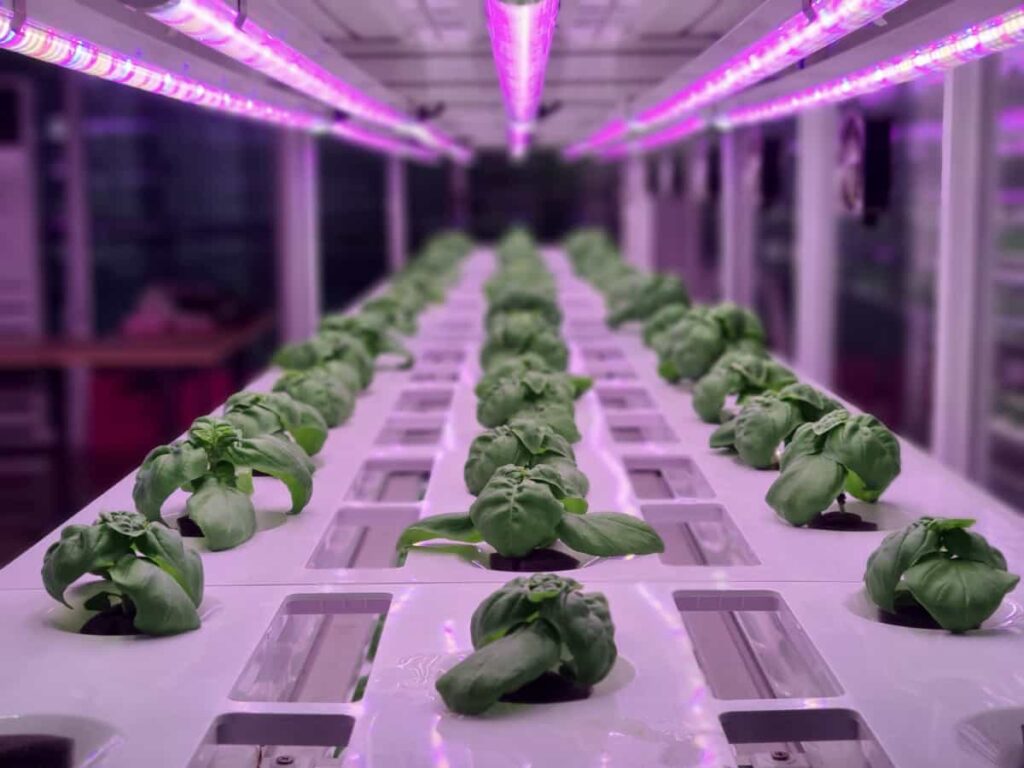
Can Technology Be Used to Grow Different Types of Crops in Vertical Farms?
Technology allows for flexibility in growing various types of crops within a vertical farm setting by customizing environmental conditions based on specific crop requirements.
Conclusion
Vertical farming is a groundbreaking approach to agriculture that takes advantage of vertical space to cultivate crops. Unlike traditional farming methods that rely on expansive plots of land, vertical farming utilizes stacked layers or shelves, often within controlled indoor environments. This innovative technique allows for year-round crop production and dramatically reduces the need for land and water.
- Profitable Village Farming Business Ideas in 2024
- High-Yield Aquaculture: Fast-Growing Fish for Farming
- Effective Fish Pond Construction Techniques for Beginners
- Irrigation and Water Management in Pineapple Farming
- Blossom to Harvest: Mastering Flowering and Pollination in Papaya Farming
- Pig Fattening Essentials: From Selection to Sale for Beginners
- Raising Wagyu Cattle: A Complete Guide for Premium Beef Production
- Soil Types and Their Water Holding Capacity
- Optimizing Irrigation Schedules for Coconut Groves for Enhanced Yield
- Espresso Your Garden: Coffee Grounds for Healthier Acid-Loving Plants
- The Best Soil Mix for Snake Plants: How to Mix Your Own Snake Plant Soil
- Green Thumb Success: Expert Tips for Cultivating Greenhouse Beans All Year Round
- Bloom All Year Round: The Ultimate Guide to Indoor Hyacinth Care
- Eco-Friendly Gardening: How to Make Liquid Fertilizer from Kitchen Waste
- Ultimate Guide to Grow Anise in Pots: Explore Seed Propagation to Harvesting
- Guide to Raising Chester White Pigs: Discover Breed Facts to Growth Management
- Mastering the Elegance: The Ultimate Guide to Weeping Cherry Tree Care, Planting, and Maintenance
- Ultimate Guide to Planting Garlic in Grow Bags: Growing Strategies for Beginners
- How to Fix Spider Plant Leaf-Related Problems: Natural and Organic Remedies
- 10 Reasons Why Your Tulsi Plant is Shedding Leaves: Home Remedies and Solutions
- Optimizing Growth and Yield: The Advantages of Palm Bunch Ash Fertilizer
- Utilizing Neem Oil Extract as a Natural Pesticide for Hydrangea
- From Soil to Harvest: Various Ways in Which Farmers Can Use AI Tools
- Steps to Encourage and Induce Citrus Flowers: A Comprehensive Guide
- How to Fix Snake Plant Leaf-Related Issues: Natural and Organic Remedies
- Transform Your Garden into a Fragrant Oasis with Raat Ki Rani (Night Blooming Jasmine)
- Discover the Ideal Chicken Breeds for Philippine Farms
- How to Create a Poultry Egg Farm Business Plan for Profits
- Grow Lemon Cucumbers Like a Pro: Insider Techniques for Bountiful Yields
- Ultimate Guide to Caring for Your Pink Princess Philodendron: Tips for Thriving Variegation
- Areca Nut Profit Per Acre: Calculating Yield and Cost of Cultivation
- How Kaveri Chicken is Becoming a More Profitable Breed in Indian Backyards
- Transform Your Barn: 9 Steps to Convert a Horse Stall into a Chicken Coop
- Exploring Suffolk Sheep Disadvantages with Limitations and Challenges
- Guide to Solving Potted Lemon Tree Problems: How to Revive Lemon Tree in Containers
- Steps to Encourage Female Pumpkin Flowers: Best Strategies for More Flowers and High Yields
